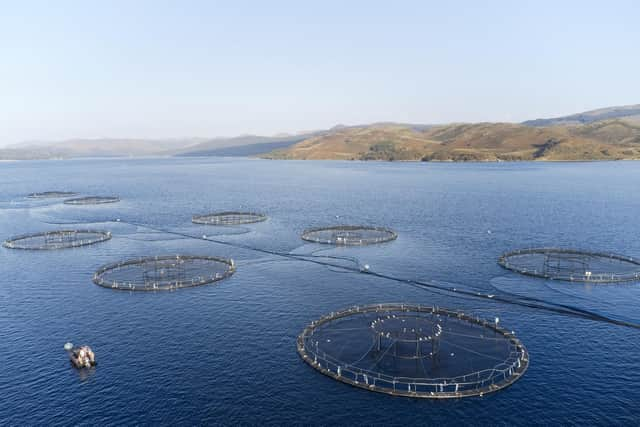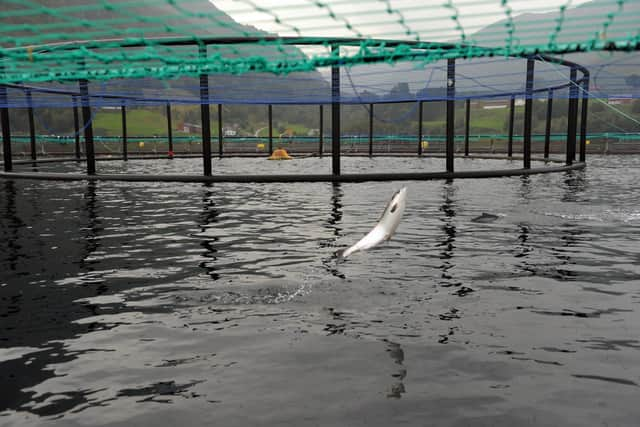Salmon fatalities at fish farms ‘double’ in past year, figures suggest
Data from the Fish Health Inspectorate and fish farming industry reports shows the death rate of cultivated fish reached record levels in 2022, jumping to all-time monthly highs in September, October and November – statistics for December are not yet available.
Estimates suggest the total number of deaths would be in the region of 15 million fish over the 11 months of the year, a jump from full-year totals of 8.58m in 2021 and 5.81m in 2020.
Advertisement
Hide AdAdvertisement
Hide AdThe record-breaking death toll comes not long after the country celebrated its biggest ever annual output of farmed Atlantic salmon, with more than 205,000 tonnes produced in 2021.
Producers have blamed a number of factors, including parasites, diseases and high micro-jellyfish numbers, possibly caused by climate change.
Farmed salmon generated £760 million for the Scottish economy in 2021.
Scottish ministers have set out ambitions for output to reach up to 400,000 tonnes a year by 2030.
However, pressures have been mounting on the sector, with criticism over heavy use of chemicals and medicines, pollution of the seabed and reliance on harmful deterrent devices to ward off predators like seals.


Reports from the Scottish Government show the annual survival rate for farmed salmon was 74.4 per cent in 2019 – the most recent period for which the rate can be calculated – meaning one in four fish died over the two-year production cycle. The rate was 75.9 per cent in 2018 and 73.8 per cent in 2017.
Fish die prematurely on farms for several reasons, including handling or transportation, treatments to tackle pests and disease, algal blooms, severe weather, escapes and predation.
Tavish Scott, chief executive of membership body Salmon Scotland, played down the losses.
Advertisement
Hide AdAdvertisement
Hide Ad“Throughout the year there will be different environmental pressures that affect survival rates,” he said. “Farm-raised Scottish salmon typically face the biggest challenges in the autumn, when seawater temperatures peak.


“Data we voluntarily publish shows survival of farm-raised salmon was consistently high during 2022, until September, when jellyfish blooms reduced survival to 95.3 per cent that month – 2.4 points down on the past four-year average of 97.7 per cent.“Salmon farmers look after their fish daily and do everything they can to provide world-leading animal health and welfare standards so it’s devastating when the fish in their care fall to naturally occurring challenges.”
But campaigners claim the death rates highlight poor welfare of farmed fish.
“The aquaculture industry has the audacity to boast of its fish ‘survival rates’, as though it is somehow acceptable for millions of individual fish to die each year from violent lice treatments or rough weather conditions,” said Abigail Penny, executive director of anti-cruelty charity Animal Equality UK.
“Viewed as little more than numbers on a page, these animals suffer such a miserable existence that many don’t even make it to the slaughterhouse.”
Farmed salmon is a major income stream for Scotland, bringing in around £760 million in 2021.
Scottish ministers have set out ambitions to expand the industry, with a target to produce between 300,000 and 400,000 tonnes a year by 2030.
However, pressures have been mounting on the sector in recent years, with criticism over heavy use of chemicals and medicines to tackle pests and diseases, pollution and use of harmful deterrent devices to ward off predators like seals.
Advertisement
Hide AdAdvertisement
Hide AdActivist Don Staniford, director of protest group Scamon Scotland, called for an end to fish farming.
“Farmed salmon are suffering intolerable cruelty in their millions,” he said.
“Salmon cages are ethically bankrupt and must be closed down to end the torture. Scottish salmon farming is dead in the water.”
Comments
Want to join the conversation? Please or to comment on this article.